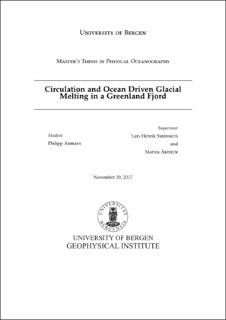| dc.description.abstract | The Nioghalvfjerdsbræ (79NG) is a floating ice tongue on Northeast Greenland draining a large part of the Greenland Ice Sheet. New hydrographic observations show that Atlantic Water (AW, T > 0 °C, S > 34.3 psu) recirculates across Fram Strait and flow onto the continental shelf having a mean temperature of about 0.6 °C. The AW is steered by complex bathymetry from the shelf toward the main glacier front of 79NG and into the cavity below its 80km ice tongue. AW presence is documented with a mean maximum temperature of 1.8 °C at 350m depth in a trough on the continental shelf with a cold halocline layer between 40m and 100 m. A CTD profile from a rift on the ice tongue close to the northern front of 79NG shows a maximum temperature of approximately 1 °C at 610m in the cavity. An Ice-Tethered Mooring deployed in the cavity measures velocities between 5 cm s-1 - 10 cm s-1 over 160 days. Analysis of a Progressive Vector Diagram suggest that the major inflow into the cavity takes place at 250m and 370m depth. Further, waters appear to reach the grounding line within 30 days. The mean tidal velocity extracted from these data is with 1.18 cm s-1 small. AW present in the cavity most likely drive submarine melting along the ice base. Melt rates are simulated by a 1D numerical Ice Shelf Water plume model. The plume is initiated at the grounding line depth (600 m) and rises along the ice base as a result of buoyancy contrast to the underlying AW. As the plume entrains warm AW ice melts. The plume dynamics and mass, momentum, heat, and salt conservation at the ice-ocean boundary, and, hence, the melting are parameterized using an entrainment coefficient and a drag coefficient. Tides are found neither to influence the plume dynamics nor the melt rates. Maximum melt rates are 50 - 75myr-1 within 10km of the grounding line. Within a zone of rapid decay between 10km and 20km melt rates drop to roughly 6myr-1. Further downstream, melting increases again for about 5km to approximately 15myr-1 before relatively steady mean melt rates of 6myr-1 are maintained. Mean and maximum melt rates increase quadratically with rising AW temperatures. The travel time of the plume from the grounding line toward the main glacier front is roughly 9 days. Long-term variability in AW properties are examined using ocean reanalysis (ECCOv4) for 1992-2015. AW temperature and layer thickness in a trough on the continental shelf range between 0.1 °C - 1.3 °C and 45m - 100 m. Using the simulated range for AW in the plume model gives a range in mean melt rates along the centreline between 10myr-1 and 19myr-1. The corresponding freshwater flux ranges between 19km3 yr-1 (0.6 mSv) and 36km3 yr-1 (1.1 mSv). | en_US |

